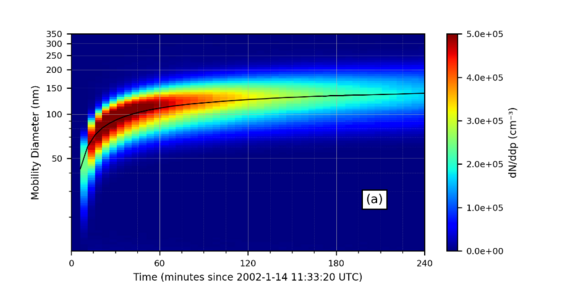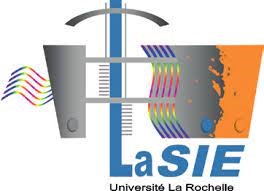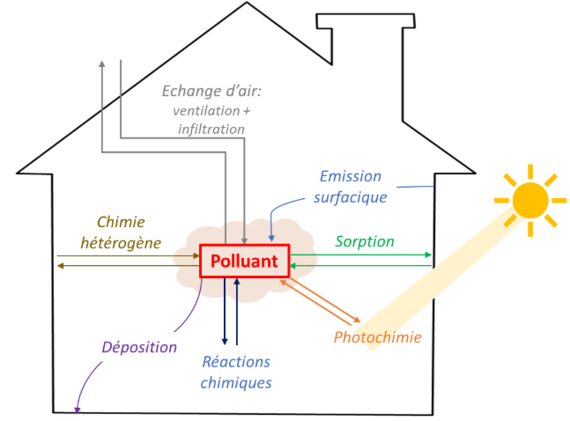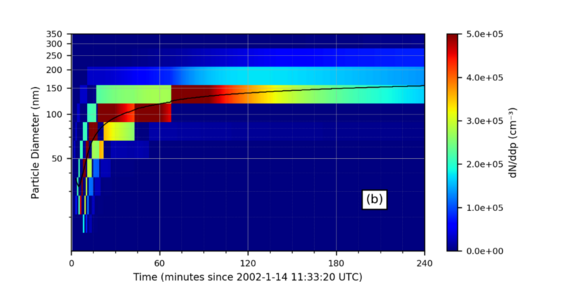

Abstract
The research aims to develop tools and methods (mainly based on modeling) to understand the physical and chemical processes that determine the level of indoor air pollution. Models are used to help to monitor and predict indoor air pollution, and propose remediation solutions.
Research objectives
Develop models that allow the simulation of indoor air pollution
Understand the physical and chemical processes that explain air pollution
Develop methods to monitor and predict indoor air pollution
Propose strategies for reducing indoor air pollution.
Projects
- AMBRRES « Multi-criteria approach for a resilient and healthy building » – 2020-2024. Coordinator : Maxence Mendez (Octopus Lab). Participants : OCTOPUS-LAB, ENGIE, NOBATEK, LIVE. Contrat : F. Breton.
- MIAQ « Development of a coupled measurement-model methodology for improved monitoring of indoor air quality » – 2019-2021. Coordinator : Nadège Blond (LIVE). Participants : OCTOPUS-LAB.
- MERMAID « Representative Experimental Measurements and Detailed Indoor Air Modeling». – 2020-2023 – Coordinator : Coralie Schoemaecker (PC2A, Lilles). Participants : PC2A, LASIE, ICPEES, ATMO-GRAND-EST, LIVE. Contrat : M. Mendez.
Few publications
- Blocquet, Marion & Guo, Fangfang & Mendez, Maxence & Ward, Michael & Coudert, Sébastien & Batut, Sébastien & Hecquet, Christophe & N. Blond & Fittschen, Christa & Schoemaecker, Coralie. (2018). Impact of the spectral and spatial properties of natural light on indoor gas-phase chemistry: Experimental and modeling study. Indoor Air. 28. https://doi.org/10.1111/ina.12450
- Rizk, Malak & Guo, Fangfang & Verriele, Marie & Ward, Michael & Dusanter, Sebastien & N. Blond & Locoge, Nadine & Schoemaecker, Coralie. (2018). Impact of Material Emissions and Sorption of Volatile Organic Compounds on Indoor Air Quality in a Low Energy Building: Field Measurements and Modeling. Indoor Air. 28. https://doi.org/10.1111/ina.12493
- Mendez, M., N. Blond, D. Amedro, D. Hauglustaine, P. Blondeau, C. Afif, C. Fittschen, C. Schoemaecker Assessment of indoor HONO formation mechanisms based on in situ measurements and modeling, Indoor Air, Published by John Wiley & Sons Ltd, 1-9, 8 July 2016b. DOI: http://doi.org/10.1111/ina.12320
- Rizk, M., M. Verriele, M. Mendez, N. Blond, S. Dusanter, C. Schoemaecker, P. Blondeau, S. Le Calvé Locoge, N. (2016). Data on comparison between FLEC and CLIMPAQ methods used for fast sorption measurements of VOCs on building materials. Data in Brief, 7, 518–523. http://doi.org/10.1016/j.dib.2016.02.072
- Mendez, M., D. Amedro, N. Blond, D. Hauglustaine, P. Blondeau, C. Afif, C. Fittschen, C. Schoemaecker, Identification of the major HOx radical pathways in an indoor air environment, Indoor Air, Published by John Wiley & Sons Ltd, 1-9, 2016a. http://doi.org/10.1111/ina.12316
- Mendez M., N. Blond, P. Blondeau, C. Schoemaecker, D. Hauglustaine, Assessment of the impact of oxidation processes on indoor air pollution using the new time-resolved INCA-Indoor model, Atmospheric Environment 122, 521-530, 2015. https://doi.org/10.1016/j.atmosenv.2015.10.025
Phds
- Berger Corentin, 2018-2021, Modeling of indoor air pollution and operational monitoring of indoor air quality. Phd directors : N. Blond, J.L. Ponche. Funding supports : ADEME/Octopus Lab, Fonds de dtation AIR (project MIAQ). Actual position : Engineer (laboratory and operational tests) at Zaack.
- Guo Fanfang, 2014-2017, Development of a model for controlling indoor air quality. Phd directors : N. Blond, J.L. Ponche. Funding supports : Chinese Scientific Council (CSC). Actual position : post-doctoral fellow at Beijing University. http://www.theses.fr/2017STRAH011
Galerie

Collaborations





Contact
Dr. Nadège BLOND
Atmospheric physicist and chemist
National Center for Scientific Research (CNRS)
nadege.blond[at]live-cnrs.unistra.fr
0033 (0)3 68 85 09 71





